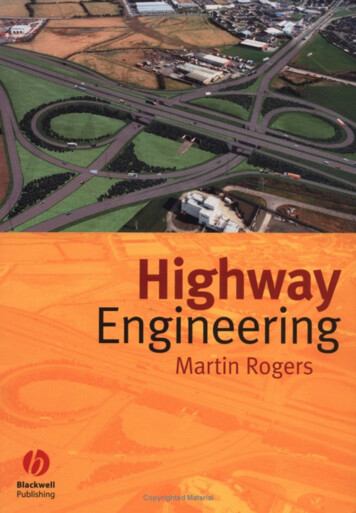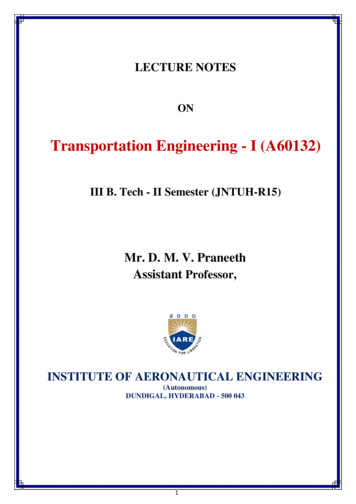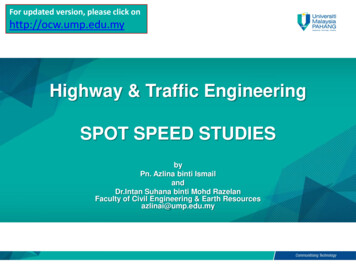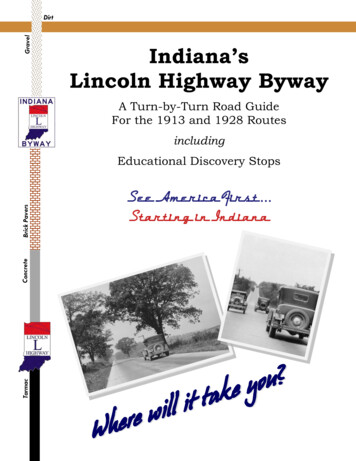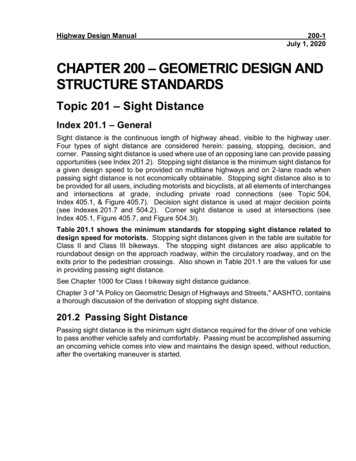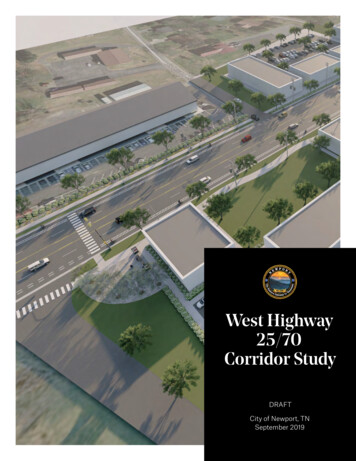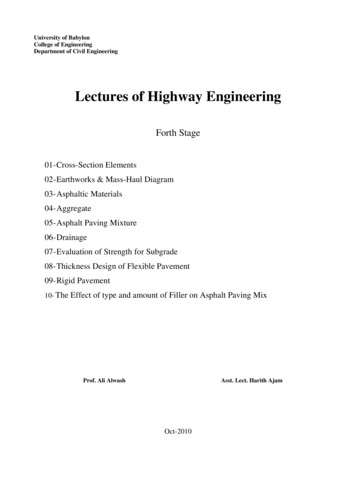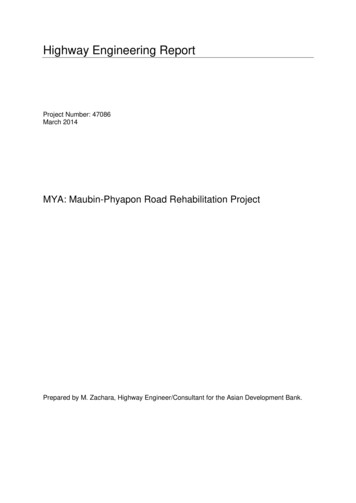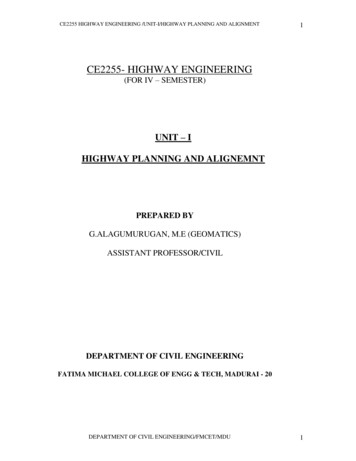
Transcription
CE2255 HIGHWAY ENGINEERING /UNIT-I/HIGHWAY PLANNING AND ALIGNMENT1CE2255- HIGHWAY ENGINEERING(FOR IV – SEMESTER)UNIT – IHIGHWAY PLANNING AND ALIGNEMNTPREPARED BYG.ALAGUMURUGAN, M.E (GEOMATICS)ASSISTANT PROFESSOR/CIVILDEPARTMENT OF CIVIL ENGINEERINGFATIMA MICHAEL COLLEGE OF ENGG & TECH, MADURAI - 20DEPARTMENT OF CIVIL ENGINEERING/FMCET/MDU1
CE2255 HIGHWAY ENGINEERING /UNIT-I/HIGHWAY PLANNING AND ALIGNMENT2UNIT-IHIGHWAY PLANNING AND ALIGNMENTHistory of Road Construction, Highway Development in India - Jayakar CommitteeRecommendations and Realisations, Twenty-year Road Development Plans, Concepts of OngoingHighway Development Programmes at National Level, Institutions for HighwayDevelopment at National level - Indian Roads Congress, Highway Research Board, NationalHighway Authority of India, Ministry of Road Transport and Highways (MORTH) and CentralRoad Research Institute. Requirements of Ideal Alignment, Factors Controlling HighwayAlignment Engineering Surveys for Alignment - Conventional Methods and Modern Methods(Remote Sensing, GIS and GPS techniques) Classification and Cross Section of Urban and RuralRoads (IRC), Highway Cross Sectional Elements – Right of Way, Carriage Way, Camber, Kerbs,Shoulders and Footpaths [IRC Standards], Cross sections of different Class of Roads - Principlesof Highway FinancingCONTENTSS.NO2 MARKSPAGE NO1.Define highway and highway engineering.62.Explain scope of highway engineering?63.4.What is the usage of road statistics? And what basis it ispresented?Give some reasons for the poor state of road development inIndia?665.What are the main features in roman roads?76.What are the advantages of road transportation?77.Give the various characteristics of roadways.78.What is mean by tresaguet construction?79.What are the steps allowed in Macadam construction?710.What are the two important principles of good road constructiongiven by John Macadam construction?DEPARTMENT OF CIVIL ENGINEERING/FMCET/MDU82
CE2255 HIGHWAY ENGINEERING /UNIT-I/HIGHWAY PLANNING AND ALIGNMENT311.Comparison between Macadam & Telford construction?812.Define CRF.813.What are the various committees and sub committees in IRC?814.Define the objectives of Twenty year Road development plan.15.How do you calculate the total length of metalled road & NH &SH & MDR?916.What are the recommendations made by the jayakar committee?917.What is mean by Bombay Road Plan?918.Define IRC.919.What are the objectives of Highway Research Board?1020.Define the main objectives of CRRI.1021.Define alignment and types of alignment.1022.What are the requirements of ideal alignment?1023.What are the factors controlling highway alignment?1024.What are the stages in engineering surveys?1125.What are the classifications of urban roads?1126.Define landwidth.1127.What is mean by Traffic lane?1128.Define camber (or) cross slope.1129.Define kerbs and types of kerbs.1130.What are the urban applications of remote sensing & GIS?1231.What are the objectives of NHAI?1232.What are the classifications of non-urban roads in India?1233.Give the various steps in new project work.1234.Define Perception.1335.Comparison between First and second 20 year road plans.13DEPARTMENT OF CIVIL ENGINEERING/FMCET/MDU3
CE2255 HIGHWAY ENGINEERING /UNIT-I/HIGHWAY PLANNING AND ALIGNMENTS.NO1.2.3.4.5.6.7.8.16 MARKSBriefly explain about advantages and disadvantages of roadtransport?Briefly explain the Tresaguet and Macadam’s method of roadconstruction?Explain the sketches the various factors controlling the alignment ofroads.Does the road in India perform the role in achieving speedyeconomic development?Briefly explain the engineering surveys needed for locating a newhighway?Discuss the Twenty-year road plan and its features?Compare the Nagpur road plan and the second twenty-year roadplan discuss the merits of each:Write short notes oni) Right of wayii) Carriage wayiii) Camberiv) KerbsDEPARTMENT OF CIVIL ENGINEERING/FMCET/MDU4PAGE NO.13151719212328294
CE2255 HIGHWAY ENGINEERING /UNIT-I/HIGHWAY PLANNING AND ALIGNMENT5TWO MARKS QUESTIONS AND ANSWERS1. Define highway and highway engineering.The term road or roadway thus constructed is therefore termed ‘highway’ and thescience and technology dealing with road engineering is generally called ‘Highway Engineering’.2. Explain scope of highway engineering?Scope of highway EngineeringPHASESDETAILSDevelopment, planning and locations----------Basis for planning, engineeringSurveys and highway alignmentHighway design, Geometrics & structures-----------Road construction and their designDesign of drainage system.Traffic performance and its control------------Traffic studies analysis.Materials, construction & Maintenance------------Maintenance of pavements andDrainage System.Economics, finance and administration------------Road user cost and economicanalysis of highway projects.3) What is the usage of road statistics? And what basis it is presented?The road statistics give an idea of the stage of road development of a country. Theroad statistics may be presented on the basis of area of the country or the population. The roadnetwork of this country has to be considerably increased during the development plans.4) Give some reasons for the poor state of road development in India?The poor state of road development in India in the past may be due to the followingreasons:i)There was no planned development of roads in the country up to theinitiation of Nagpur Road plan in the year 1943.Only during the five-yearplans since 1951; the development works were speeded up.ii)The investment even today on the road development programme is muchlower than the revenue from the road transport.iii)Poor economic conditions of the vast majority of the population in villagesprohibit the owing of private vehicles and discourage the use of transport.DEPARTMENT OF CIVIL ENGINEERING/FMCET/MDU5
CE2255 HIGHWAY ENGINEERING /UNIT-I/HIGHWAY PLANNING AND ALIGNMENT65) What are the main features in roman roads?The main features of the roman roads are: They were built straight regardless of gradients. They were built after the soft soil was removed and a hard statum was reached the totalthickness of the construction was as high as 0.75 to 1.2 meters at some places, even thoughthe magnitude of wheel loads of animal drawn vehicles was very low.6) What are the advantages of road transportation?The advantages of transportation are: Transportation is for advancement community Transportation is essential for the economic and general development of the country.7) Give the various characteristics of roadways. Roads are used by various types of road vehicles like passengers, cars, buses; trucks, twoor three-wheeled automobiles.etc.But railway tracks are used only by rail locomotives.Waterways are used by only ships.Construction & maintenance of roads is cheaper than others.FlexibilityFor short distance travel road transport saves time.Road transport is the only means of transport that offers itself to the whole communityalive.8) What is mean by tresaguet construction?Pierre Tresaguet (1716-1796) developed an improved method of construction inFrance by the year 1964.Tresaguet developed several methods of construction which wereconsidered to be quite meritorious. The main feature of his proposal was that the thickness ofconstruction need be only in the order of 30 cm.9) What are the steps allowed in Macadam construction? The construction steps are:Sub grade is compacted and prepared with a cross slope of 1 in 36 up to a desired width.Broken stones of a strong variety, all passing through 5 cm size sieve were compacted to auniform thickness of 10 cm.The second layer of strong broken stones of size 3.75cm was compacted to thickness of 10cm.The top layer consisted of stones of size less than 2cm compacted to a thickness of about 5cm and finished so that the cross slopes of pavement surface was also 1 in 36.DEPARTMENT OF CIVIL ENGINEERING/FMCET/MDU6
CE2255 HIGHWAY ENGINEERING /UNIT-I/HIGHWAY PLANNING AND ALIGNMENT710) What are the two important principles of good road construction given by JohnMacadam construction?The principles of good road construction are: It is the native soil that supports the traffic load ultimately, and when the soil is maintainedin a dry state it can carry heavy loads without settlement. Stones which are broken to small angulr pieces and compacted can interlock with eachother and form a hard surface.11) Comparison between Macadam & Telford construction?The two methods have been compared here:Macadam methodTelford methodi) The subgrade was given a cross slope of 1 The subgrade was kept horizontal and hencein 36 to facilitate subgrade drainage.subgrade drainage was not proper.ii) The bottom layer of pavement or the Heavy foundation stones of varying sizes,subbase course consisted of broken stones of about 17 cm towards the edges and 22 cmless than 5 cm.towards the centre were hand packed andprepared to serve as sub base course.iii) Base and surface courses consisted of Two layers of broken stones were compactedbroken stones of smaller sizes to compacted over the foundation stones before laying thethickness of 10 and 5 cm respectively.wearing course.iv) The total thickness of pavement The total thickness of construction variedconstruction was kept uniform from edge t from about 35 cm at the edge to about 41 cmcentre to a minimum value of only 25cm.at the centre.12) Define CRF.The Central Road Fund (CRF) was formed on 1st march 1929.The consumers ofpetrol were charged an extra leavy of 2.64 paisa per litre of petrol to build up this roaddevelopment fund 20 percent of the annual revenue. The accounts of the central road fund aremaintained by the Accountant General Revenue. The CRF has been revised in order to augmentthe revenue under this fund.13) What are the various committees and sub committees in IRC?IRC has many committees and sub committees:Committee: Bituminous committee Cement concrete committee Road Transport Development committee Research organization committee Transport operation cost committee Specification standard committeeSub Committee: Cement road concrete surfacing Education of road engineers Soil research Traffic engineeringDEPARTMENT OF CIVIL ENGINEERING/FMCET/MDU7
CE2255 HIGHWAY ENGINEERING /UNIT-I/HIGHWAY PLANNING AND ALIGNMENT814) Define the objectives of Twenty year Road development plan.The broad objectives are:i) Provision of good communication in the rural areas is essential to check increasing urbanization.ii) The future road system should besides serving the highly developed and agricultural areas, alsotake into account the needs of the semi-developed and undeveloped areas.iii) The road length should be increased as to give a road density of 32 km per 100 sq.km15) How do you calculate the total length of metalled road & NH & SH & MDR?The formulas are: A B 1.6N 8T D – RNH SH MDR (km) 8 32 Where,A Agricultural area, km2B Non-Agricultural areaN Number of towns and villages with population range 2001 -5000T Number of towns and villages with population over 5000D Development allowance of 15 percent of road length.R Existing length of railway track, km16) What are the recommendations made by the jayakar committee?The most important recommendations made by the committee are:i)ii)The road development in the country should be considered as a national interest as thecapacity of provincial governments and local bodies.An extra tax should be levied on petrol fro the road users to develop a roaddevelopment fund called central road fund.17) What is mean by Bombay Road Plan?The Second Twenty Year road development pan for the period 1961-81 wasinitiated by the IRC and was finalized in 1959 at the meeting of the chief engineers and the samewas forwarded to the central government. This road development plan is also known as Bombayroad plan.18) Define IRC.Instance of Central government a semi official technical body known as IndianRoads Congress (IRC). The IRC was constituted to provide a forum fro regular pooling ofexperience and ideas on all matters affecting the planning construction and maintenance of roadsin India.DEPARTMENT OF CIVIL ENGINEERING/FMCET/MDU8
CE2255 HIGHWAY ENGINEERING /UNIT-I/HIGHWAY PLANNING AND ALIGNMENT919) What are the objectives of Highway Research Board?i)ii)iii)iv)v)The objectives are IRC highway research Board is:To ascertain the nature and extent of research required.To correlate research information from various organizations in India and abroad.To co-ordinate and conduct correlation services.To collect and disseminate results on research.To channelize consultative services.20) Define the main objectives of CRRI.i)ii)iii)iv)v)The main objectives are:To carry out the basic and applied research for investigation, design, construction andmaintenance of different types of roads and runways.To carry out research on road traffic and transportation, including traffic safety andtransport economics.To render technical advice and consultancy services to various organizations.To arrange for utilization of results of research by extension unit, display centers etc.To conduct refresher and training courses for staff of other research Institutions,Universities and highway Departments.21) Define alignment and types of alignment.The position (or) the layout of the centerline of the highway on the ground is calledthe alignment.Types:1) Horizontal alignment2) Vertical alignment22) What are the requirements of ideal alignment?The basic requirements of ideal alignment between two terminal stations are that itshould be:a)b)c)d)ShortEasySafeEconomical23) What are the factors controlling highway alignment?The various factors, which control the highway alignment, may be listed as:a) Obligatory pointsb) Trafficc) Geometric designd) Economicse) Other considerationsIn hill roads additional care has to be given forDEPARTMENT OF CIVIL ENGINEERING/FMCET/MDU9
CE2255 HIGHWAY ENGINEERING /UNIT-I/HIGHWAY PLANNING AND ALIGNMENTa)b)c)d)10StabilityDrainageGeometric StandardsResisting Length24) What are the stages in engineering surveys?The stages of engineering surveys are: Map study Reconnaissance Preliminary surveys Final location and detailed surveys25) What are the classifications of urban roads?The road system within urban areas is classified as urban roads. The urban roads, otherthan express ways are classified as: Arterial roads Sub-arterial roads Collector roads Local roads26) Define landwidth.Right of Way is the area of land acquired for the road, along its alignment. Thewidth of this required land is known as landwidth.27) What is mean by Traffic lane?The pavement or carriageway width depends on the width of traffic lane andnumber of lanes. The carriage way intended for one line of traffic movement may be called atraffic lane.28) Define camber (or) cross slope.Cross slope (or) camber is the slope provided to the road surface in the transversedirection to drain off the rainwater from the road surface.29) Define kerbs and types of kerbs.Kerbs indicate the boundary between the pavement and shoulder (or) sometimesislands or foot path or kerbs parking space. Kerbs may be divided into three groups:i)ii)iii)Low (or) mountable types kerbsSemi-barrier types kerbsBarrier type kerbs.DEPARTMENT OF CIVIL ENGINEERING/FMCET/MDU10
CE2255 HIGHWAY ENGINEERING /UNIT-I/HIGHWAY PLANNING AND ALIGNMENT1130) What are the urban applications of remote sensing & GIS?The urban application of remote Sensing and GIS are: In creating construction material Inventions Engineering soil mapping Slope stability studies Highway planning and highway engineering Power line location Pipe line location Site surveys for town planning31) What are the objectives of NHAI?The NHAI was established under the national highway authority of India act 1988.The objectives are: Take responsibility of development and maintenance Improve and extend the NH network in an efficient Improve road safety including road geometric Provide on route facilities for road users. To promote the scheme of three plantations along the roads as well as beautify allmajor intersections and junctions.32) What are the classifications of non-urban roads in India?The classifications are: National highways (NH) State highways (SH) District highways (DH) Major district roads Other district roads Village roads (VR)33) Give the various steps in new project work.The Various steps are: Map study Reconnaissance survey Preliminary survey Location of final alignment Detailed survey Materials survey Design Earth work Pavement construction Construction controlsDEPARTMENT OF CIVIL ENGINEERING/FMCET/MDU11
CE2255 HIGHWAY ENGINEERING /UNIT-I/HIGHWAY PLANNING AND ALIGNMENT1234) Define Perception.Perception is the process of perceiving the sensations received through the sensoryorgans, such as the eyes, ears, skin, nose and the brain. It is recognition of the sensations andbecoming aware of the information transmitted.35) Comparison between First and second 20 year road plans.The comparison is:First 20 year planSecond 20 year plan1) It divides the area into two categories It divides the area into three categories namelynamely,1) agricultural 2) Non agricultural1) Developed and agricultural 2) Semideveloped 3) Undeveloped2) The towns have been divided into six The towns have been been divided into ninepopulation ranges with Max as 5000 & above.population ranges with Max as 100000 above.3) It allowed deduction for the length of railway It did not allowed deduction for the length oftrackrailway track.4) The development allowance was taken as 15 The development allowance was taken as 5 %% of road lengthof road length.16 Marks Questions and Answers1) Briefly explain about advantages and disadvantages of road transport?Wide Geographical Coverage provided by roads:Roads can be constructed to penetrate the interior of any region and to connectremote villages. The advantage becomes particularly evident when planning the communicationsystem in hilly regions and sparsely populated areas.Low Capital investment:Roads can be constructed at comparatively lower initial cost than railways. The costof roads varies with specifications, but even the best road is cheaper than a railway line.Quick and assured deliveries:Time is great value for a wide range of articles; including both perishables and highvalue is manufactured products. Road transport by its quick deliveries reduces the need for largerinventories and locking up of working capital a great cost.DEPARTMENT OF CIVIL ENGINEERING/FMCET/MDU12
CE2255 HIGHWAY ENGINEERING /UNIT-I/HIGHWAY PLANNING AND ALIGNMENT13Flexibility:Road transport offers a flexible service, free from fixed schedules. Any number oftrucks or buses can be pressed into service quickly to meet sudden demand or withdrawn .Such aflexibility is absent in railways, which operate generally according to fixed schedules.Door-to-door services:Road transport offers door-to-door service, free from transshipments from origin todestination. Railways on the other hand have to depend upon road transport for picking up loadsand making deliveries.Simpler packaging:Road transport permits simpler packaging and crating for the protection of goodsagainst breakage.Personalized service:A personal touch is generally present in road transport. The customer is given inindividualized attention in various matters.Employment potential:Road transport has a high employment potential. This is an important factor in acountry with a large and employment problem.Personalized travel:Travel by private car or motorized two wheeler or even a cycle, satisfies personalpleasures.This is one of the main reasons for the popularity of personalized travel mode in the developedcountries.Short hauls:For short hauls transport is there only economical means if a major project is to beconstructed and is the construction materials have to be transported through short distances oneturns only to road transport.Safety:One of the serious advantages of road transport is its poor record of safety. Roadaccidents have become a serious menace, claiming enormous economic loss to the nation.DEPARTMENT OF CIVIL ENGINEERING/FMCET/MDU13
CE2255 HIGHWAY ENGINEERING /UNIT-I/HIGHWAY PLANNING AND ALIGNMENT14Environmental pollution:Road transport has been one of the major causes for environmental pollution, noisefumes, vibration, loss of aesthetics, ribbon development these are the some ill effects.Parking problem:Road transport has caused parking problem of serious proportions in city streets.Long hauls:It has been found that most commodity movements are cheaper by road for shorthauls up to 300-350 kms, but beyond this range, the cost advantage lies with the railways.Energy:Road transport consumes greater energy per passenger km and tonne km thanrailways.2) Briefly explain the Tresaguet and Macadam’s method of road construction?Tresaguet construction:*) Pierre Tresaguet (1716-1796) developed an improved method of construction inFrance by the year 1964.The main feature of his proposal was that the thickness of constructionneed be only in the order of 30 cm.*) Tresaguet was the inspector General of roads in France from 1775 to 1785.So hismethod of construction was implemented in that country in 1775.*) The typical cross section of tresaguets road construction is given in fig. and theconstruction steps may be enumerated as below.DEPARTMENT OF CIVIL ENGINEERING/FMCET/MDU14
CE2255 HIGHWAY ENGINEERING /UNIT-I/HIGHWAY PLANNING AND ALIGNMENTi)ii)iii)iv)15The sub grade was prepared and layers of large foundation stones were laid on edge byhand. At the two edges of the pavement large stones were embedded edge wise to serveas submerged kerbs stones.The corners of the heavy foundation stones were hammered and then the intersticesfilled with smaller stones.The top-wearing course was made of smaller stones and compacted to a thickness ofabout 5 cm at the edges and gradually increased towards the center.The shoulders were also provides cross slope to drain the surface water to the sidedrain.Macadam ConstructionJohn Macadam put forward an entirely new method of road construction ascompared to all the previous methods. A typical cross section of Macadam construction:i)ii)iii)iv)The importance of sub grade drainage and compaction were recognized and the subgrade was compacted and was prepared with a cross slope of 1 in 36.Macadam was the first person to suggest the heavy foundation stones are not at allnecessary to be placed at the bottom layer of construction.Though the total thickness of construction was less than previous methods. Thistechnique could serve the purpose in a better way.The size of broken stones for the top layer was decided based on the stability underanimal drawn vehicles.DEPARTMENT OF CIVIL ENGINEERING/FMCET/MDU15
CE2255 HIGHWAY ENGINEERING /UNIT-I/HIGHWAY PLANNING AND ALIGNMENT16Macadam’s method is the first method based on scientific thinkingThe construction steps are:i)ii)iii)iv)Sub grade is compacted and prepared with a cross slope of 1 in 36 up to a desiredwidth.Broken stones of a strong variety, all passing through 5 cm size sieve were compactedto a uniform thickness of 10cm.The second layer of strong broken stones of size 3.75 cm was compacted to thicknessof 10 cm.The top layer consisted of stones of size less than 2 cm compacted to a thickness ofabout 5 cm. The cross slope of pavement surface was also 1 in 36.3) Explain the sketches the various factors controlling the alignment of roads.The various factors, which control the highway alignment, in general may be listed as: Obligatory points Traffic Geometric design Economics Other considerationsIn hill roads additional care has to be given for Stability Drainage Geometric standards of hill roads Resisting length.Obligatory Points: These control points may be divided in to two categories:i)Points through which the alignment is to passii)Points through which the alignment should not pass.*) Obligatory points through which the road alignment has to pass may cause the alignment tooften deviate from the shortest (or) easiest path.In fig.1.shows how the straight alignment AB is deviated along the hillside pass, thus avoiding atunnel (or) heavy cutting.DEPARTMENT OF CIVIL ENGINEERING/FMCET/MDU16
CE2255 HIGHWAY ENGINEERING /UNIT-I/HIGHWAY PLANNING AND ALIGNMENT17In fig.2.shows that the straight alignment between stations A and B which passes across the riverband is to be deviated along the path shown in order to cross the river at a proper bridge location.ii) Obligatory points through which the road should not pass also may make it necessary to deviatefrom the proposed shortest alignment.*) The obligatory points, which should be avoided while aligning a road, includereligious places, very costly structures.*) However if there is no alternative and the alignment has to be taken across suchan area, the construction and maintenance costs are likely to be very high.Traffic: The alignment should suit traffic requirements origin and destination study should becarried out in the area and the desire lines be drawn showing the trend of traffic flow.Geometric design: *) Geometric design factors such as gradient, radius of curve and sight distance alsowould govern the final alignment of the highway.*) The absolute minimum sight distance, which should invariably be available in everysection of the road, is the safe stopping distance for the fast moving vehicles.Economy: *) The alignment finalized based on the above factors should also be economical.*) The initial coast of construction can be decreased if high embankments and deepcuttings are avoided and the alignment is choosing in a manner to balance the cutting and filling.DEPARTMENT OF CIVIL ENGINEERING/FMCET/MDU17
CE2255 HIGHWAY ENGINEERING /UNIT-I/HIGHWAY PLANNING AND ALIGNMENT18Other considerations: *) Various other factors, which may govern the alignment, are drainage considerations,hydrological factors, political considerations and monotony.*) The vertical alignment is often guided by drainage considerations.*) In a flat terrain it is possible to have a very long stretch of road, absolutely straightwithout horizontal curves.Special considerations: Stability: While aligning hill roads, special care should be taken to align the road along the sideas the hill, which is stable. The cutting and filling of earth to construct roads on hillside causessteepening of existing slopes and affect its stability.Drainage: Numerous hillside drains should be provided for adequate drainage facility across theroad. But the cross drainage structures being costly, attempts should be made to align the road.Geometric standard of hill roads: Different sets of geometric standards are followed in hill roads with reference togradient, curves and speed and they consequently influence the sight distance, and radius of curveand other related features.Resisting length: The resisting length of a road may be calculated from the total work to be done tomove the loads along the route taking the horizontal length. The actual difference in levelsbetween the two stations and sum of ineffective rise and fall in excess of floating gradient.4) Does the roads in India perform the role in achieving speedy economic development?Roads in India perform a variety of roles in achieving speedy economic development.Some of the important aspects are discussed below:Connection to villages:India is a country having 590,000 villages, scattered into small habitations and oftenlocated in the extreme interior. Thus social uplift, health and education of the village population isaided by roads.DEPARTMENT OF CIVIL ENGINEERING/FMCET/MDU18
CE2255 HIGHWAY ENGINEERING /UNIT-I/HIGHWAY PLANNING AND ALIGNMENT19Communications in hilly terrain:For the hill states located along the Himalayan range, communication facility ispossible only by roads because of the steep terrain involved.Strategic importance:The defence of the northern, north-eastern and western borders of the country isdependent to a large extent on the road system.Helps agricultural development:Roads have fostered quicker agricultural development facilitating movement ofmodern inputs such as fertilizers and high yielding seeds.Helps dairy development:Since the cattle wealth of the nation is concentrated in innumerable villages and smallhabitations, the collection and processing of surplus milk only because of roads.Forestry development:The forest wealth of the country is being exploited mainly because of the roads whichpenetrate in to the thick jungles.Fisheries Development:The Development of the fisheries along the coast line has been rendered possiblebecause of the construction of link roads leading to the coast.Tourism Development:Some of the ancient monuments, religious places, natural parks and sanctuaries areaccessible only roads. Tourism, both domestic and international, has been greatly aided by roadsserving such as places of interest.Employment:As already stated, roads and road transport provide employment to a large number ofpeople in the country. Since road construction involves labour intensive techniques in India, thelarge unemployed labour force gets gainful employment.Famine and flood relief:Roads have helped operations pertaining to flood and famine relief. The affectedpeople are frequently employed on road construction to build durable assets.DEPARTMENT OF CIVIL ENGINEERING/FMCET/MDU19
CE2255 HIGHWAY ENGINEERING /UNIT-I/HIGHWAY PLANNING AND ALIGNMENT20Administrative convenience:Roads have helped the effective administration of this large country. Maintenance oflaw and order and dispensation of justice have been aided by roads. National integration andcohesion have been brought about by roads which traverse the length and breath of the country andwhich link people from different parts together.5) Briefly explain the engineering surveys n
1. Define highway and highway engineering. The term road or roadway thus constructed is therefore termed ‘highway’ and the science and technology dealing with road engineering is generally called ‘Highway Engineering’. 2. Explain scope of highway
